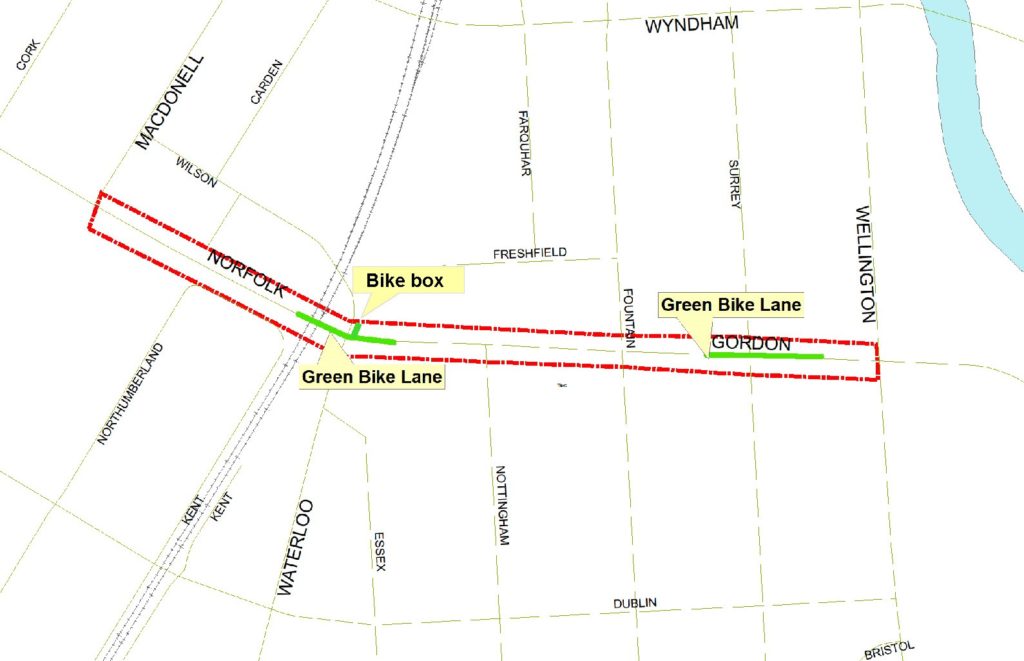On this page
Waterloo Avenue to Wellington Street
The City of Guelph is piloting and evaluating changes to Gordon Street bike lanes to decrease the number of collisions between people driving, walking and biking.
Gordon Street southbound bike lanes will be painted green through the intersection at Waterloo Avenue, and from through the intersection at Surrey Street. Lines marking the bicycle lanes in both the northbound and southbound directions of Gordon Street will be painted thicker (20 cm) to increase the visibility of bike lanes to people driving this route.
A bicycle box will be added at Gordon Street and Wilson Street to help people riding bikes to make left hand turns. Bike boxes help improve the safety of people driving and biking by making people who are biking more visible to divers. Bike boxes help people biking to cross multiple lanes of traffic safely in order to make a left turn at busy intersections like this one.
These changes will make bicycle lanes more visible, signaling all road users to use extra caution at intersections and driveways, and reminding turning vehicles to slow down and watch for other road users, including people who are walking and biking.
Background
This pilot project was developed in response to the high number of reported collisions involving people driving, walking and biking on Gordon Street between Waterloo Avenue and Wellington Street.
There were 300 collisions on Gordon Street between Waterloo Avenue and Wellington Street from January 1, 2011 to December 31, 2016:
- 207 (69 per cent) of the collisions led to an injury
- 35 (11.6 per cent) of the collisions involved people cycling, an average of six per year
- 22 (63 per cent) of the collisions involving people cycling happened while the cyclist was following the rules of the road
- three (eight per cent) of the collisions involving people cycling happened when the cyclist failed to yield the right-of-way
- nine (three per cent) of the collisions involved people walking, an average of 1.5 per year
- 198 (66 per cent) of the collisions happened during turns into and out of businesses and roads
There are frequent conflicts between drivers and active transportation users on this stretch of the road. A number of hazardous factors contribute to the challenge:
- Southbound (downhill) bicycles are travelling close to the speed of cars
- Traffic volumes create lengthy queues that block driveways and side streets, and make it difficult for turning vehicles to see people who are walking and biking
- Drivers who wave turning vehicles through into driveways and cross streets may not be seeing people walking or biking, nor can the driver that is turning
- Visual noise such as signs and traffic activity make this section of road busy and distracting
- There are many closely-spaced driveways and cross streets that create potential conflict points as different road users cross paths
Bike lane painting is aimed at improving road safety for all users and to reduce conflicts.
For more information
Allister McIlveen,
Manager of Transportation Services
Transportation Services, Infrastructure Design and Enterprise Services
519-822-1260 extension 2275
[email protected]
Jennifer Juste,
Transportation Demand Management Coordinator
Transportation Services, Infrastructure Design and Enterprise Services
519-822-1260 extension 2791
[email protected]

